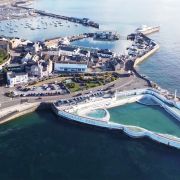The oldest part of Penzance is the quay. From here it extended up what is now Chapel Street which is rich in history and contains an eclectic mix of buildings and businesses. Most of the street dates back to the mid 18th century but there are a few reminders of the more distant past.
The street gets it's name from the Chapel of St Anthony, although where exactly this was I'm not sure. The current day church, St Mary's, was built between 1832 and 1835 by Charles Hutchins on the site of St Mary's Chapel. The site dates back to the 14th century.
Just up from St Mary's is a small row of houses - what makes these unusual is they are constructed from bricks and not granite as most of the buildings in Penzance are. They were built in the late 18th century and referred to as Rotterdam Buildings as it is said they were built with money from Dutch prizes taken by a Penzance privateer. At the time brick was regarded as being of higher status than granite.
It is in one of these houses(no. 25) that Maria Branwell lived - she was the mother of of Charlotte, Anne, Emily and Branwell Bronte.
On the opposite side of the road from St Mary's is what is now Penzance Arts Club. A fairly imposing building with it's classical facade looking out over the quay, it was in former times a Portuguese Embassy. This asserts the importance of Penzance as trading port in the past.
Back on the other side of the street a little further up is the vicarage. A three storey granite building, this was originally the home of the Usticke family.
Competing for the title of the most colourful building on the Street is the Admiral Benbow pub. Named after the 17th century Admiral John Benbow the pub is also famed for being in the opening scene of Treasure Island by Robert Louis Stevenson. The first thing you'll probably notice is the statue of a smuggler lying astride the roof, musket in hand.
The inn was converted from cottages which explains the low ceilings and small paned windows. Inside there is a nautical feel with loads of interesting artefacts form dives such as cannons and bits of ships.
The next building of any great interest on Chapel Street is the Turks Head, reputedly the oldest pub in the town. In the 1820s the pub was run by a Holloway. He was the father of Thomas Holloway who went on to become an incredibly rich pill and ointment maker, In fact when he died he left £700,000 to build the Holloway College in Surrey which I presume is now part of the Royal Holloway and Bedford.
Across the street from here is the Wesleyan Chapel. Built in 1814 it has undergone many restorations and 'improvements' over the years. It is a slightly pretentious building with a white colonnade and paved courtyard at the front.
Between here and the next place of any historic interest are a few quirky little shops including the 'Chocolate House' at no. 44, an Indian restaurant a bar and the Regent Hotel.
Just up from here is the Union Hotel. It's claim to fame is that it was here that the victory of the battle of Trafalgar was announced but also the death of England's greatest naval hero, Admiral Horatio Nelson. The news was brought to Penzance by local fishermen who had intercepted HMS Pickle on her way to Falmouth.
Perhaps Penzance's most extravagant building is situated accross the street from the Union - The Egyptian House with it's colourful lotus columns and stylised cornices really does stand out.









